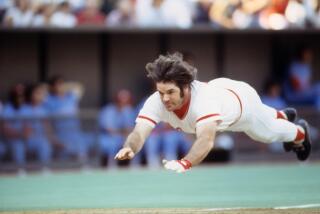Chris Davis and others deal with fallout from baseball’s steroid era
NEW YORK — Barry Bonds was here.
His is the name that evokes all that went right, and so very wrong, for baseball during the steroid era. His spirit was here Monday, the day before the All-Star game, when baseball’s premier slugger declared Bonds’ single-season-record 73 home runs null and void.
“In my opinion, 61 is the record,” Chris Davis said, “and I think most fans agree with me on that.”
Roger Maris hit 61 in 1961. Bonds bettered that once, Mark McGwire twice, Sammy Sosa three times. All three have been linked to steroids, and all three have fallen far short of election to the Hall of Fame.
Davis, the Baltimore Orioles’ first baseman, has 37 home runs, on pace for 62. That would be the new record, if you believe Davis, and if you believe in him.
“I think there is no reason not to believe in me,” he said.
This is what Bonds and his era wrought. Commissioner Bud Selig could soon impose drug suspensions en masse in a sport he insisted Monday is “cleaner than it’s ever been.” Davis sounded more like a defendant than a slugger when he met with reporters here.
He spoke in even tones, with confidence and not with bitterness. He was 12 years old in 1998, when McGwire and Sosa chased each other, and chased down Maris. Then Bonds chased down steroids, and then came the reckoning.
“I think the ’98 season really brought baseball back to life, after the strike,” he said. “It was obviously disheartening to find out down the road what came out about all of that.”
Davis is 27, an age when batters peak. He hit 33 home runs last year. He is better, he said, at “not swinging at balls that are 14 feet out of the strike zone.”
And yet he hears he must be on something, some performance-enhancing substance. He denies it, but when he talks about how often he is tested, you cannot help but think that some two dozen guys who passed drug tests could be on the verge of suspension. Selig spent millions on investigators, to collect whatever other evidence they could find.
Davis must face the questions because Bonds and Co. failed him. The strength of the players’ union lies in how one generation of players sacrificed for the next, but the previous generation of players left this one open to suspicion.
“That’s kind of what we were looking at when we turned over the rock on this whole thing,” Davis said. “It’s something you kind of have to expect. . . . You just have to wear it and go with it.”
If mass suspensions are announced, is that a good day for baseball or a bad day? Infielder Brandon Phillips of the Cincinnati Reds played it both ways.
“It’s going to be a good day for me, because my name is not on there,” Phillips said. “It’s going to be a bad day for those guys that are kicked out of baseball — and for those guys that were clean, that are at their house watching those guys and saying, ‘Dang, I could still be playing.’
“For the guys that might get suspended, they are going to hurt their team. They could be the superstars on their team, and if they get 50 or 100 games. . . . The only reason their team was winning was because of them. That’s going to be a bad thing.”
Funny he should mention that. The American League All-Star team includes outfielder Nelson Cruz of the Texas Rangers, the team two games out of first place in the American League West.
“He’s been the most important part of our team for sure,” Rangers closer and fellow All-Star Joe Nathan said.
He might not be, not for much longer. News reports say Cruz’s name was among those found in the records of a Miami clinic being investigated by MLB.
Nathan said he trusts that the Rangers’ front office has contingency plans in the event Cruz is suspended for violating baseball’s drug policy. One of them — no joke — is two-time violator Manny Ramirez, who recently signed with the Rangers.
As the steroid era waned, players guessed how many of their peers might have been using performance-enhancing drugs. Jose Canseco suggested eight in 10, Ken Caminiti five in 10. In an Athlon Sports survey of 146 players this spring, 75% said no more than one in 10.
There is a goal, Nathan said. Drug testing is one of the means toward the end.
“Justice,” Nathan said. “We want a fair playing field. As far as players that have not taken that stuff, we just want an even playing field out there.”
That would change the subject, mercifully. Davis mentioned how someone had told him he ought to keep track of how often he is tested, the better to respond to reporters questioning his legitimacy.
“I’m not going to write it down — every time I pee — for you guys,” he said.
That is one statistic we can live without.
twitter.com/BillShaikin
More to Read
Go beyond the scoreboard
Get the latest on L.A.'s teams in the daily Sports Report newsletter.
You may occasionally receive promotional content from the Los Angeles Times.











